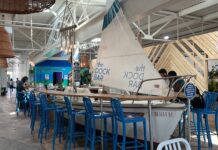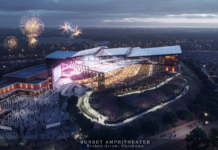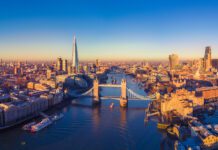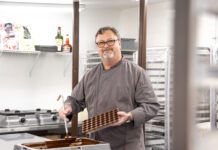Welcome To Boomtown
In 1907, the year Oklahoma achieved statehood, the little town of Tulsa had a population of 7,298 – roughly the size of modern day Ponca City. If nothing else, Tulsa was a well-positioned town located along the railroad with water transportation options via the Arkansas River.
After a small oil deposit was discovered in Red Fork – what is now west Tulsa – people took notice of this unremarkable town. When a large deposit of oil was found in Glenpool, people started pouring into Tulsa in search of new riches.
“When Tulsa’s first boom occurred, Tulsa was in the right place at the right time,” says Maggie Brown, director of exhibits and education with the Tulsa Historical Society. “Basically, what these two occurrences did was catch the attention of individuals and businesses that had oil wells across the country. They began flocking to Tulsa in search of more oil.”
Because of the already established infrastructure and location on the railroads, Tulsa was prime real estate for those seeking to cash in on the region’s recently discovered liquid gold. From the time oil was initially discovered, the population began doubling every few years. As such, Tulsa truly embodied the word “boomtown.”
In 1898, the population was 1,100. After the Glenpool discovery, the population was nearing 4,000, and by 1920, Tulsa was home to 72,075 residents.
Oil Capital of the World
And so it was that the small town along the railroad tracks boomed, more than quadrupling in size during a very small window of time. “At one time, basically every major oil company in the country had an office here,” explains Brown. “That’s one of the reasons Tulsa became known as the Oil Capital of the World.”
With the growing population came growing wealth. It was during this time of great prosperity in the oil industry that Tulsa’s skyline started to take shape. Many of downtown’s benefactors, including Waite Phillips – founder of Phillips Petroleum and of Philbrook, Philcade and Philtower fame – wanted his buildings to reflect the most modern architecture at that time. Enter Art Deco.
“Here’s this new city with all these new millionaires and they’re working in an industry that is developing new technology all the time,” Brown says. “Maybe they’ve moved here from New York City or the coast, and they wanted to establish Tulsa as the place to be. They wanted this city to reflect the technology and their wealth and that it was new.”
While other cities, such as Oklahoma City and Kansas City, are experiencing similar booms during this time, the lavish scale on which the cities’ patrons doled out on their buildings doesn’t compare to the ostentatious Tulsans.
“There is so much money in Tulsa and the standards are so high,” says Dr. Bob Blackburn, president of the Oklahoma Historical Society. “These people are used to spending large amounts of money.”
It was because of this “money is no object” attitude that Tulsa today has one of the largest collections of Art Deco real estate.
“Tulsa’s buildings are generally of a higher quality of architecture styling, ornament, form, beauty, function and space,” Blackburn says. “There are churches and retail and hotels, and suddenly you have that classic skyline that’s there by 1930.”
By 1931, the Philcade Tower, Waite’s second skyscraper, was complete, but as with all booms, there comes a bust, and it’s during this time that the country was in the throes of an economic depression.
“What happens in the 1930s and ‘40, is that the first Great Depression freezes the skyline,” Blackburn explains. “Even people like Waite Phillips are donating their buildings because they are getting out – he gives Philtower to the Boy Scouts of America.”
After experiencing substantial population growth since the early 1900s, the Depression all but arrests the influx of people, and Tulsa fails to increase more than one percent between 1930 and 1940. What was once a roaring downtown has started what would turn out to be a slow decline.
Ghost Town
According to Blackburn, as the depression continued into the ‘40s with the war, Tulsa experiences a burst of suburban highway construction with the Broken Arrow Expressway. Most of the new construction in the 1950s is concentrated more in midtown and the suburbs. While there is a resurgence of traditional oil companies and their building offices, they’re not necessarily in downtown.
Slowly, businesses began moving out toward the suburbs, and there was not as much incentive to make the way to downtown to go shopping. It was now all in everyone’s backyards. The culture of downtown began to change. After the 1980s oil glut and the city’s biggest industry took a massive hit, downtown Tulsa was a shadow of its once former glory.
The teardowns of the Art Deco buildings began in the 1960s and ‘70s. No longer a symbol of wealth and often considered tacky, many ornate theaters, Deco gas stations and office buildings were demolished to make room for new office buildings and, in many cases, surface parking.
“There would have been a time that many hated Art Deco because it was old,” Brown says. “It’s a cycle that cities go through. You build buildings, and sometimes you tear them down and sometimes you just hope that some of the things that are left are great.”
A Vision for the Future
After the oil crisis in the 1980s, the city tried to diversify and rely more heavily on other industries, such as aerospace, but the old spunk and vitality wasn’t there. Many offices still maintained their locations downtown, but many moved out farther in the city, closer to the suburbs, or left the state entirely for larger cities, such as Dallas.
Aside from the 9-to-5 office operations still residing downtown, there was very little going on to encourage people to stay after work. Regional counterparts, including Oklahoma City that had passed its MAPS capital improvement program, were surpassing Tulsa, and morale was low. Young professionals left to pursue opportunities in greener pastures that offered more of a nightlife and urban culture.
The writing was on the wall for the once-upon-a-time Oil Capital of the World. City and county leaders noticed this “brain drain” trend and put their backs into developing what would become known as Vision 2025 in an effort to boost the economy and bring business back to downtown.
“The greater Tulsa region was at a crossroads in early 2002,” says Mike Neal, president and CEO of Tulsa Metro Chamber. “Economically, things were bad and community leaders realized the region needed to adapt quickly to the post-industrial, global economy or face a long, slow slide into economic turmoil.”
According to Neal, the city was ranked second in the nation in terms of high unemployment and had lost approximately 17,000 well-paying jobs in the years leading up to the introduction of the package. Additionally, the region’s aerospace, energy and telecommunication sectors had all suffered serious financial setbacks. Public facilities, such as the Tulsa Convention Center, were falling apart, and city sales taxes were sharply down. Schools were facing major decreases in funding, as well.
“There had been some previous efforts and some recognition that the downtowns in some of our peer cities were flourishing and being revitalized, yet downtown Tulsa had been struggling,” Julie Miner, principal economic development planner with INCOG, says. “Yet we knew it was the heart of our city and where we began, and so there was some pent-up frustration that we needed to do more.”
Miner, who at the time of Vision 2025 served as the development director for the City of Tulsa, believes it was the integrated approach of bringing together Tulsa’s citizens and leaders by Mayor Bill LaFortune that gave Vision 2025 the leg up over previous plans that were floated to voters.
“(The previous efforts) seemed to be more top-down, rather than ground-up,” Miner says. “One of the first things that Mayor LaFortune did was to invite everyone who was interested to the Convention Center. Outsiders were brought in to discuss how their cities had done the revitalization efforts. This process drew in people from all walks of life.”
During this time, there was also a federal tax credit focused on urban renewal that provided monies for restoring and rehabbing historic buildings, and Oklahoma had a very limited version of the tax incentive as well. Miner says that Tulsa was able to initiate an expansion of the historic tax credits to renovate historic buildings.
“We were able to provide a tax credit that just blossomed and gained a tremendous amount of momentum. The state tax credit was expanded to mimic that of the federal credit. The city started getting people from all over looking to invest in these buildings,” she says.
Unlike the past efforts, Vision 2025 had the backing of Tulsa County commissioners, regional mayors, INCOG and the Tulsa Metro Chamber. According to Neal, each party was active in the planning process and organization of the package, while Bob Dick and Mayor LaFortune were the public champions of the package. Step Up Tulsa was another backing organization that was comprised of industry and business leaders.
“There were some naysayers, though,” Miner says. “I remember one gentleman showing a slide of downtown that he’d taken from Oakland Cemetery and said that ‘we need to get over this – downtown is dead.’ He felt that we didn’t need to spend any money or put any public investment in these projects. Thankfully, there were enough people who did not share his sentiment and wanted to make this work.”
The collaborative effort proved successful and Vision 2025 passed. Undoubtedly, the biggest impact of the tax package on downtown was the funding for the BOK Center. Striking in its spherical shape and iconic glass curtain wall, since the opening of the BOK Center in 2008, there has been a flurry of construction activity in downtown, bringing retail, restaurants and patrons back to the city’s business center.
“Since that time, there has been between 20 to 25 major projects that have occurred in addition to the Vision projects,” says Miner. “The John Hope Franklin Memorial, the Hardesty Arts Center, ONEOK Field and the Mayo Hotel. There’s a geothermal park that’s being built right now in the Brady district.”
Adds Neal, “More than $350 million in private development has been constructed, is under construction or is in the pipeline – this is being induced by the highly successful BOK Center, revitalized historic buildings and continued growth in residential construction downtown.”
Downtown Rising
Blackburn believes that Tulsa is at an important crossroads with the current momentum moving forward in the direction of progress and is looking to make a home for the Oklahoma Museum of Popular Culture in the Brady District at Cincinnati and Archer.
“What is happening right now, in both Oklahoma City and Tulsa, is the re-emergence of the spirit of the city that we had before 1930. Urban planners in the 1960s were saying that downtown is not relevant and looked at ways to develop the suburbs. That generation is gone and now we have a new generation. The baby boomers that grew up in the suburban flight era are hungry for the excitement of an urban center.”
“Local enjoyment of downtowns is a national trend,” Neal says. “The younger generation is demanding a more urban experience, one that puts work, entertainment, recreation and other amenities all within walking distance of home. For this group, there is less emphasis on having large homes, yards and cars and more interest in a community lifestyle.”
In answer to these demands, One Place – a mixed-use office, retail, hotel and residential space, is currently under construction. Situated in a prime location across from the BOK Center, the first phase of One Place’s office tower will be newest addition to the city’s skyline.
One Place Developer Bob Eggleston, who also was on the Tulsa Vision Builders team that built the BOK Center, has called downtown home since the first shovel of dirt was turned on the arena.
“When I leased the building at Second and Cheyenne for the Tulsa Vision Builders office, it was always in the back of my mind that a developer would come in and would want to buy this block,” Eggleston says. “It makes absolute sense. Near an arena or an off-ramp, that’s where you want to develop.”
As luck would have it, no other developers came calling, so Eggleston and One Place Development partner, Hank Pellegrini, decided that they would develop the land themselves. Negotiating with the Tulsa Development Authority, Eggleston and Pellegrini were able to acquire one square city block for their mixed-use development, and the gamble has paid off.
With initial plans excluding office space due to a 23 percent vacancy in Class B and C office space, it was felt that there would be little interest in more of the same space. However, when oil company Cimarex came looking for a new place to base their headquarters, there was a noticeable deficiency in Class A office space in the area. Enter One Place.
“Once we secured the Cimarex deal, we had an overwhelming interest in office space,” says Eggleston. “We have just short of 600,000 square feet under construction. Northwestern Mutual, a south Tulsa company, came along – and they wanted to move downtown, so that was our next office. If we did nothing else on the project, we’ll have about 700 people in those two buildings.”
Fortunately for downtown’s current and would-be residents, they’re not just stopping at the two office spaces. The next announcement will be for the hotel portion of the development, followed by retail.
“We’re operating on the ‘park once’ mentality. You can drive to work and park once. You never have to get in your car and drive to something – everything is already here. For that young professional, within one city block, they can really live, work and play.”
Others share Eggleston’s point-of-view, and have put their hats in the downtown arena.
“With the tremendous amount of public investment through Vision 2025, I saw the opportunity within the Central Business District for a limited service hotel and a Marriott brand,” Jeff Hartman, operating partner with SJS Hospitality, says. “We actually have two hotels downtown – Courtyard by Marriott in the Deco District and Fairfield Inn & Suites in the Brady Village. Both locations are booming with growth but cater to a different market.”
With Vision 2025 wrapping up in 2016, Tulsans can expect to see another package on the horizon.
“We would assume a similar package will be proposed at the appropriate time as future needs are predicted to maintain the current momentum established by Vision 2025,” says Neal.
“As a historian, there’s got to be a public/private partnership,” says Blackburn on the importance of continuing public investment in downtown. “Sometimes, you think you could do away with the public side and everything would be fine. Vision 2025 was a great example of a public/private partnership. It was critical, and without it, what’s happening probably would have happened, but it would’ve been a lot slower, it would have looked differently and with less central coordination.”
In addition to bringing the urban culture back to Tulsa, downtown is a vital component to any major city and its surrounding communities.
“As former Mayor Hudnut of Indianapolis has said, ‘You can’t be a suburb of nothing,’” says Neal. “Our regional partners understand the necessity of a vibrant downtown Tulsa to their own economic well beings. In addition to being the national and regional headquarters of several corporations, downtown Tulsa also provides a multitude of arts, attractions, entertainment venues and restaurants which contribute to the quality of life and attractiveness of our overall region. And an exceptional quality of life is key to keeping and attracting new businesses and a talented workforce.”
Adds Miner, “Our downtowns are really our collective memory. It’s where our founders began. You can’t really distinguish a town by its suburbs. It’s your downtown that gives you that uniqueness, that sense of place. It’s really a visceral response.”
The Rising
On the morning of April 22, 1889, Oklahoma laid out equal opportunity for anyone willing to put hard work into building it into the place that would provide the opportunities they couldn’t find elsewhere.
Boomers who had finally convinced the government to open the Unassigned Lands had their sights firmly set on the Sante Fe Railroad’s Oklahoma Station as the place to build their new city.
Nearly overnight Oklahoma City was built on the backs of men who saw the potential for a great city. Oklahoma City’s founding fathers exploited Oklahoma City’s mid-continent location on the shores of a river and the crossroads of the railroad system to attract businesses. A warehouse district was created to service the railroad, and industrial sectors and downtown popped up to house and provide shopping for the new residents.
From the day of the Land Run until the state was admitted into the Union in 1907, the population of Oklahoma City grew from about 10 railroad workers and support staff to more than 30,000 residents.
The next decade would see the population increase by 100 percent. The growth remained among the nation’s fastest until the Great Depression halted development nationwide.
Depression Halts Growth
The Great Depression’s impact was minimized as oil was found below Oklahoma City in 1928 just before the stock market crashed. The influx of oilmen and prospectors provided jobs and stimulated the economy with retail business. Still downtown was not immune from the havoc of the economic crisis and private investment and development halted in the city.
Suburbanization and federally subsidized highways after World War II all but killed downtown Oklahoma City. By 1947 the streetcar tracks were ripped from the city streets and downtown became a place people came to work during the day. Retail left downtown as developers invested in building along the new highway system where their money would go further.
The warehouse district built on the railroad slowly turned into a ghost town as interstate commerce was moved from tracks to trucks.
Slash and Burn Renewal
The post-World War II era saw a period of urban decay that ate a doughnut hole of rot in most inner cities, says Bob Blackburn, executive director of the Oklahoma Historical Society. Through the 1950s and 1960s, the rot spread to the outlying suburbs, and there was a national inner city issue. The federal government stepped in with a program of urban renewal so that cities could make development in the core as cheap as it was in the suburbs, Blackburn says.
“A good site downtown is an empty site,” Blackburn cites as the philosophy.
An Urban Renewal Authority was established by the city council, and Oklahoma City embraced its efforts with a vengeance, demolishing Victorian brownstones, the historic Biltmore Hotel and leveling much of Deep Deuce – the once-thriving black section of Oklahoma City – to make way for I-235. Historic preservation wasn’t a consideration.
“Oklahoma City was more aggressive in getting federal funds than any other city in the U.S.,” says Blackburn.
World-renowned architect and city planner I.M. Pei was hired to assist with the urban renewal. The resulting Pei Plan unveiled in 1964 called for a near wiping of downtown to make way for mixed-use buildings, a convention center, hotel and an outdoor garden that would bring retail and residential growth back to downtown.
Public opinion over time would cast a dark shadow on this period of urban renewal as a great loss. Historic treasures were razed with little benefit of the forecasted retail or residential growth, leaving much of downtown vacant lots. However the Myriad Convention Center (now the Cox Convention Center), the Myriad Botanical Gardens and the Sante Fe Parking Garage did slip out of this period.
Boom and Bust
In the 1970s, Oklahoma City found itself in the middle of another oil boom – this one so large that TV commercials told viewers that if they didn’t have an oil well they should get one. Blackburn says bankers were loaning money out like crazy. Downtown was graced with the first new privately funded buildings in more than 30 years, including the Kerr McGee Building (now home to Sandridge Energy), Liberty Tower (now Chase Tower), Fidelity Bank (now Park Harvey Center) and the Sante Fe Parking garage.
The oil boom quickly came to a close when a surplus caused prices to fall. In 1982 Penn Square Bank collapsed, the first of more than 100 banks that became insolvent during the 1980s. Penn Square’s depositors took major losses, and Oklahoma City was sent into what Blackburn calls the Second Great Depression.
“People were moving out. Oil, gas, farming and ranching were down,” he says.
Any development that had been in the plans was ceased. Downtown was but a shell of what it had been or was supposed to have become.
Brick By Brick
In 1979 Neal Horton took a gamble on the purchase of brick buildings in the abandoned warehouse district that miraculously had been ignored and thus saved from urban renewal’s ravages. He saw the potential for an entertainment district, but wasn’t able to surmount the economic decline of the 1980s.
Jim Brewer took up the campaign and invested in Bricktown in the mid-1980s. He spent the rest of his life promoting and developing the area and was known as the unofficial mayor of Bricktown.
In 1989, 100 years after the birth of Oklahoma City, Texas-based Spaghetti Warehouse became the first restaurant in Bricktown, pushing downtown a baby step toward rebirth.
“Spaghetti Warehouse was only opened for dinner. People would already be lined up at 4 p.m.,” says Michael Dean, the spokesperson for the Oklahoma Historical Society.
The out-of-the-gate success inspired Brewer to open O’Brien’s Bricktown Club, and in 1992 he opened the state’s first brewpub, the Bricktown Brewery. The same year, the Blazers began playing hockey at the Myriad Convention Center just steps from the Brewery, generating traffic.
“Blazers hockey played a huge role,” says Jim Cowan, Bricktown Brewery’s first general manager. He later became owner and subsequently served as director of the Bricktown Association.
Bricktown became a destination as businesses like the Brewery held concerts and hosted festivals; Brewer brought events to the district. Its location at the intersection of the city’s major highways as in the center of the city made it a suitable common meeting place for people coming from every corner of the metro area.
“In the early ‘90s, people who lived in Oklahoma City had been in Dallas’ West End and wanted something cool like that,” says Cowan.
Cowan says the hope that Oklahoma City could be home to something like Dallas’ West End prompted Oklahoma City to support it.
He points to passage of the one-cent sales tax to fund the Metropolitan Area Projects (MAPS) as a sign of the huge civic pride that Bricktown was built on.
“Bricktown to me symbolizes the fact that we were the underdog and we did it. And we did it because we were willing to invest in ourselves,” Cowan says.
MAPSing out the Future
While Bricktown was growing from private development, the city’s center was in need of a major overhaul. Oklahoma City was regularly passed over as a location for corporate headquarters and mayor Ron Norick got sick of being a “bridesmaid on economic development.”
“We always came in second place,” says Norick.
When United Airlines passed over Oklahoma City, it was the final straw for Norick. The city had voted in a one-cent sales tax to fund facilities at Will Rogers Airport for United Airlines that would be put in place only if the airline chose the city as its headquarters. He wagered that if voters were willing to pay money to improve Oklahoma City for someone else, they would be willing to pay money to improve Oklahoma City for themselves.
He convened committees to look at performing arts, sports, business and every other aspect of the city. He hired a consulting firm to get feedback on how to attract business to downtown. The outcome was MAPS, a set of nine improvements to resurrect downtown.
The city’s triple-A baseball team was in jeopardy if their facility was not upgraded. A new ballpark would be built in Bricktown. A canal would also wind through Bricktown to draw people to the area.
The severely outdated Civic Center Music Hall would receive a makeover, and the city’s aging library would be replaced. A trolley system would service downtown and Bricktown.
The North Canadian River that was drained as a WPA project during the Great Depression would be rehabilitated to create opportunity for outdoor activities along its shores.
The Ford Center (now Chesapeake Energy Arena) would be built as a venue for sports and music and the Myriad Convention Center expanded to create more opportunity to play host to national conferences.
Aside from improvements to the Fairground to secure Oklahoma City as the horse showing capital of the world, all MAPS development was proposed for Bricktown and downtown.
Norick wanted a central location to create an area that would attract restaurants, bars and retail. He wanted MAPS to be a catalyst for private development. And he was adamant that the improvements be considered one project.
“If we passed the convention center, or if we passed the river and the trolley, what did we have? Nothing,” he says.
Only as one project could the initiative succeed. He says because some people like arts and some people like sports. The sports people weren’t going to vote against the proposal because of the arts inclusion, but they probably wouldn’t vote for the arts development alone.
Then he took it to the citizens of Oklahoma City and asked, “Wouldn’t you like to have your kids work and live in Oklahoma City instead of Dallas or Chicago?”
At the end of 1993 the voters agreed to pay a one-cent sales tax to fund MAPS.
United By Tragedy
While the City of Oklahoma City was saving up those pennies to begin construction, an act of unthinkable violence rocked the city’s core. The bombing of the Alfred P. Murrah Federal Building in April 1995 united the city.
“People ask me, ‘Was the bombing good for Oklahoma City?,’” says Kirk Humphreys who served as Oklahoma City’s mayor from 1998 to 2003. “No, I do not believe the bombing was good for Oklahoma City. But I do believe our response to the bombing was good for Oklahoma City. I think we amazed ourselves.”
Humphreys says the city’s long-standing inferiority complex was shattered as citizens realized the city was special in its own right. The city’s fixation with other cities as examples of all the things it was not melted. This sea change created a willingness to grow Oklahoma City.
“It didn’t make us, but it did reveal us,” says Humphreys.
Finish MAPS Right
The citizens of Oklahoma City had trust issues with the city and remained skeptical of MAPS until the Bricktown Ballpark opened in 1998. Humphreys was successful in changing attitudes toward MAPS and passed Finish MAPS Right, a measure to extend the one-cent sales tax when MAPS went over budget.
Humphreys says without this, Oklahoma City would not have the arena, which means that the city would also be absent the Thunder. Without MAPS he believes downtown might not even have the Devon Tower today because the city would not have been attractive to the kind of people needed to grow Devon Energy.
“When I got elected mayor we kept very few of our college graduates,” says Humphreys. “We were exporting our human capital.”
The revitalized downtown has created job opportunities where once there were few. Now, young people have a reason to stay in Oklahoma after college.
In 1999, at the grand opening of the Cox Convention Center, Humphreys was looking out the window and two blocks away saw the boarded up Skirvin Hotel.
“It was a hulking symbol of failure,” he says.
After laying out his options he decided he did not want to be the mayor who tore down the Skirvin. The city bought the Skirvin in an effort to better control the flow of its investment into the renovation. In 2007, it was reopened, a milestone without which, Mayor Mick Cornett says, the downtown renaissance would have been hollow.
The Second Great Decade
Blackburn credits the opening of the Bricktown Ballpark in April 1998 with propelling downtown into full-blown renaissance and beginning what he calls Oklahoma City’s second great decade.
“It’s a different city now,” Blackburn says.
The outcomes of the downtown renaissance are great, but most agree the revived spirit was the greatest accomplishment.
“I think people feel proud. It is bigger than bricks and mortar,” Norick says.
Cowan agrees, “You could highlight the businesses. But to me it is civic pride. I think we have the Thunder today because of downtown and Bricktown.”
Humphreys says the renaissance of downtown gave Oklahoma City the heart that every great city must have.
“Much of it is yet to be written. MAPS3 is going to propel us into a whole other generation of downtown improvements,” says Cornett.
Downtown: Live, Work, Play
Abandoned for the suburbs, downtown Tulsa and Oklahoma City became shadows of their former glory days. Now, our economy is booming and a combination of public and private initiatives has renewed our downtowns and our collective spirits. Oklahoma Magazine looks at the history of these urban centers from birth to bust to renaissance, and we spotlight the downtown districts and projects to watch.
The Rising
Downtown Oklahoma City sprang from nothing and grew into the heart of the city, twice.
by Lindsey Johnson
The Place To Be
Downtown OKC offers a diverse array of attractions that makes it a hotbed of activity for locals and visitors.
By Tara Malone
Welcome To Boomtown
The Oil Capital of the World has finally found its vision for the future.
By Katie Williams
On The Verge
Revitalization efforts have already transformed downtown Tulsa into a vibrant urban core, and much more is on the way.
By Marnie Fernandez
Business Is Good
What makes a good meal? Or better yet, what makes a good night out? Two men named James Blacketer think they know the answer, and if the enduring success of the restaurants the father-son duo has created is any indication, they’re certainly on to something. Together, their budding Los Cabos Mexican Grill and Cantina franchises and the one-year-young Waterfront Grill are bringing in both cash and customers in droves – and they’re not doing it by cutting costs. Contrarily, they’re pouring a lot of that money back into the communities that support them, through being frontrunners for charitable work, sponsorships for youth sports, and providers of good pay for good work for the hundreds of employees who work alongside them.
The first Los Cabos location was opened in May 2005 by James Jr. and Sr., whose close-knit company – which also includes the senior Blacketer’s other son, Jeb as a partner – had been working in the restaurant business for years. Instantly successful, they expanded the upscale Mexican eatery to a Broken Arrow location, and opened the Waterfront Grill in March 2011, with eyes on the market in Kansas City for more Los Cabos locations in years to come.
James Sr. says the restaurants have always been successful.
“I think the theme of the restaurants was part of it,” he says of the success, noting three contributors – the authentic, upscale décor, the well-chosen locales on water and a focus on entertainment.
“People leave their homes and feel like they’re going on vacation for a couple of hours, with their kids or on their own,” James Sr. muses. He says that the restaurants balance both adult and family clientele by simultaneously providing relaxing outdoor cabana bars and kid-friendly entertainment like mariachi bands, clowns and balloon animal artists. ?
But the broader picture shows that the two restaurants satisfy more than just the appetites of their communities.
“We create over 500 jobs in the market, and we are one of the largest restaurants in support of charitable events,” says James Jr., co-founder, head chef and creator of the Los Cabos menu. According to his approach, a satisfied staff makes for a satisfying restaurant.
“We’re in the people business, I really feel that way. We treat our people well. I have seven employees that have been with me since 1999,” James Jr. says. “I think that shows that strength of our company.”
Which is not to say that the menus suffer by comparison. “We have the best products in the United States with regards to the quality of our food,” James Sr. says, noting the crafted balance of Tex Mex, Sonoran and Coastal cooking Los Cabos in particular offers. “We have a full menu that encompasses a lot of things that you typically won’t find in Mexican restaurants.”
Take this attention to culinary diversity, along with a principled daily usage of fresh, not canned, food, high quality service backed by 13 years of experience in the restaurant business, and couple it with familial care for the people who work there, and it’s not hard to see why the venues are successful, winning numerous awards and accolades.
40 Under 40
There are overachievers, and then there is Oklahoma Magazine’s 40 Under 40 Class of 2012. These 40 individuals represent the cream of the crop in their respective industries; from health care and education to business and entertainment, we present 40 movers and shakers that make Oklahoma a more exciting place to live.
Spain In Ascent
Just a few years ago, one couldn’t pop a Champagne cork in a wine shop without it landing on a shelf with a hot new Australian, South African or Chilean wine. These days, though, trend and market demand have converged to draw the attention of oenophiles to other parts of the world.
“Spanish wines have become particularly popular,” says Mary Stewart, owner of Ranch Acres Wine & Spirits. “There are a group of wines that are good and very reasonably priced. You can get a decent bottle of wine for $10.”
Just don’t expect to search Spanish wines for those wise buys on the traditional varietals one might expect of French and California wines. Instead, Spanish Grenache and Tempranillo are the way to go in terms of reds, with the occasional solid, affordable Syrah as well.
In terms of whites, Stewart says Albarino and Verdejo are among the most popular today locally.
Stewart says value has been the impetus for market changes, and shelves reflect those changes.
“I think Australia just priced itself out of the market some,” she says. “Chile is down because Argentina is now in the market with Malbec and also their Torrontes, white wines.”
Drink Your Cake
Given the choice, I almost always choose cake over beer. Cake comforts me in a way that beer just can’t compete with. It falls flat, if you will.
I stuck by this choice until Ireland sauntered into my life with a novel idea: beer in cake. Guinness, to be exact. I first heard about the cake last summer when I was cooking Ireland for my Global Table Adventure. My first thought? “I can’t believe it’s not St. Patrick’s Day!”
My next thought? Should Guinness Chocolate Cake prove to be as delicious as it sounds, I would no longer have to choose between the two. I could have my cake and drink it, too. I immediately got to work, sure that, if all of Ireland eats the cake, it had to be good. Really good. While the famous black-and-white drink is generally too bitter and thick for my tastes – you can practically cut it with a knife – Guinness turns out to be the perfect complement to dark chocolate. The bitter booze enhances the cake’s chocolaty flavor; similar to the way a tablespoon of good espresso gives chocolate cake a big boost of flavor.
As if adding beer to my cake wasn’t a big enough adventure, I went the full mile and made a fluffy Bailey’s buttercream frosting, imitating the pure white head that crowns the beer; the secret to the super-white buttercream is mixing it for five to 10 minutes. As the butter oxidizes, it changes from creamy yellow to snow white. The sweet frosting balances the deep chocolate flavor, and the combination makes this cake my husband’s number one birthday cake request.
Those concerned about giving alcohol to kids, take comfort; the alcohol cooks off. Even the Bailey’s in the frosting only amounts to the amount of alcohol you’d find in good vanilla extract.
Sasha Martin is cooking one meal for every country in the world. Her picky husband and baby girl are along for the ride. Join the adventure for recipes, reviews and more at www.globaltableadventure.com.
Guinness Chocolate Cake
1 1/2 sticks butter
3/4 c. unsweetened cocoa
1 c. Guinness Extra Stout
1 tbsp. vanilla extract
1 1/2 c. sugar
1 1/4 c. flour
1 tsp. baking soda
2 eggs
For the buttercream:
3 sticks unsalted butter, softened
3 c. powdered sugar, sifted
2-4 tbsp. Bailey’s, as needed
Preheat the oven to 350 degrees. In a small saucepan, melt butter and whisk together with Guinness, vanilla extract and cocoa. Remove from heat. While the Guinness mixture is cooling, grease and line two eight-inch cake pans with parchment paper. Next, whisk together the dry ingredients (sugar, flour, baking soda). Pour the Guinness mixture onto the dry ingredients, then whisk in the two eggs. When the batter is shiny and smooth, pour evenly into two prepared cake pans. Bake for 30-35 minutes, or until a skewer comes out clean. Once the cakes are done baking, cool completely.
Meanwhile, make the buttercream by whipping together the softened butter and sugar in a standing mixer, then adding in just enough Bailey’s to get it loose and fluffy. The key to white frosting is to whip it a long time – the longer you whip it, the whiter it will become. I whipped ours for 5-10 minutes. I only needed 3 tablespoons of Bailey’s – you know what to do with the extra.
To assemble the cake, level the layers with a serrated knife, if needed. Then, add the frosting for the middle layer and top with second layer. Wiggle the cakes around until they line up just right. Next, do a crumb coat. This is optional but highly recommended so you don’t get brown crumbs in your white frosting. To do so, coat top and sides with another 1/3 of the frosting mixture. Spread it all over, nice and thin. Refrigerate to set it. At this point, you can refrigerate the cake overnight.
Once the crumb coat is firm to the touch, add the final 1/3 of the frosting to the cake – top first, then sides. Spread it around evenly. Slice and serve with an extra cold Guinness or a glass of milk.






















